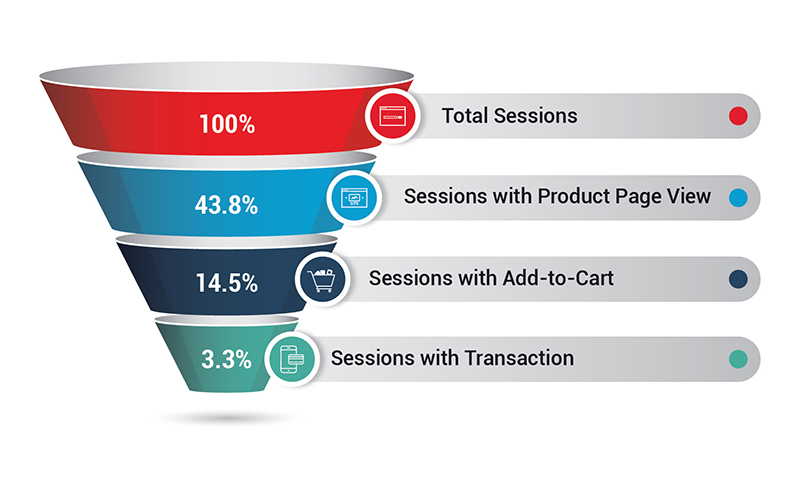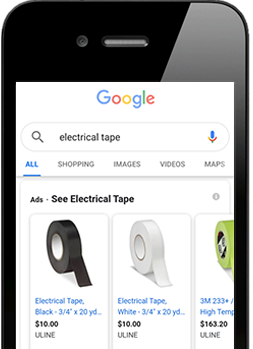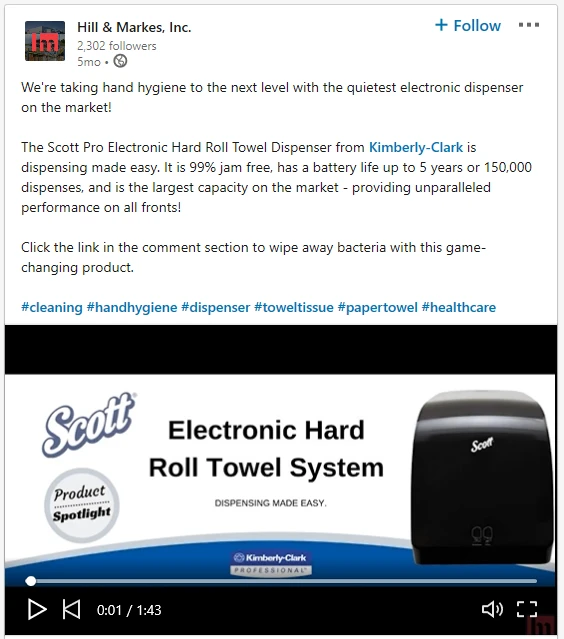At Unilog, we strongly advocate using analytics to gain important insight about your digital branch’s performance, as well as your site visitors’ behaviors and your customers’ intents. With a multitude of metrics to track and measure, analytics help you determine where and how to fine-tune your website in order to make it more useful for buyers and increasingly profitable for your organization.
In our white paper, Google Analytics for Wholesale Distributors, we explore the many capabilities of Google’s free analytics tool and guide readers through each step to set up web analytics and execute reports. In addition, we also share this simple yet effective site optimization equation to calculate online revenue:
Sessions x Conversion Rate x AOV = Revenue
Together, these three metrics determine just how much revenue your digital branch is producing; but individually, even the smallest increase in any one of the variables will guarantee you higher revenue.
Since these three components have a direct impact on your site’s ROI, we will explore each one in more detail and provide tangible ways to positively affect them. In this blog post, the first in our three-part series, we’re focusing on the first metric in the site optimization equation: sessions.
Why sessions matter
Sessions represent the number of active visits to your website. One session equals the group of interactions or actions a user has on your site during a single visit, which can include browsing site pages, downloading documents, and making transactions. In Google Analytics, a new session begins after 30 minutes of user inactivity, or the next time he or she returns to your site. Additionally, sessions include both new and repeat visits; therefore, if a single user actively visits your site three times, Google considers that three sessions. You always want to see new visitors come to your site, but repeat visitors are also desirable because they indicate you have a loyal customer base.
Unlike number of visits, number of sessions provides a more accurate gauge of who is interacting with your site. Google’s 30-minute timeout default helps eliminate distorted data by discounting anyone who is considered a passive visitor, such as a person who keeps your website open in one tab while they’re browsing the Internet on a different tab.
Top-of-funnel marketing starts with sessions
If you want to see more online transactions through your digital branch, implement a top-of-funnel marketing strategy that starts with the initial stage of the buyer’s journey: brand awareness and engagement. Using lead generation tactics (which we’ll discuss below), top-of-funnel marketing is a great way to attract visitors to your site, and hopefully convert them into customers.

Let’s say you have 1,500 sessions over the course of a month, with a current conversion rate (the percentage of site visitors who completed a transaction) of 2% and AOV (the average amount buyers spend per transaction) of $100. Using the equation, your online revenue comes out to $3,000:
1,500 sessions x 2% conversion rate x $100 AOV = $3,000 revenue
Now, if you can increase your number of sessions from 1,500 to 2,000, and your conversion rate and AOV remain the same, your revenue increases $1,000:
2,000 sessions x 2% conversion rate x $100 AOV = $4,000 revenue
“The key is to make the top of the funnel as large as possible,” says digital marketing and analytics expert, Chris Jones. “The larger the top of the funnel, if all things remain equal, the greater number of transactions you can close.”
Steps to increase sessions
There are several ways to attract potential buyers to your site as well as keep them engaged while on your site. The more methods you employ, the greater your chances of making stronger connections with them. By building strategic marketing campaigns, enlisting the help of creative and knowledgeable thought leaders, and harnessing the power of search engine optimization, you’ll soon see your number of sessions rise.
- Develop a strong SEO strategy
The initial step in creating awareness of your digital branch is through search engine optimization (SEO). Search engines like Google constantly look for website pages that offer high-quality content, contain relevant keywords, meta descriptions and tags, and are optimized for mobile devices. When a person performs an Internet search, Google looks for web pages related to that search. The more relevant pages they find on a website, the higher they rank that site on the search engine results page (SERP). Additionally, Google has configured their search results algorithms to give SERP preference to sites that are built for mobile viewing. To render a true, optimized mobile experience, you must have a responsive-designed website. A responsive web design improves your SEO on two fronts: it helps Google scan, index, and organize your online content, and it allows site users to share your content and engage with you. Adding keywords and descriptions to site content helps increase your organic search results, but you can also invest in paid advertising to improve your share of SERP. Consider starting an AdWords campaign to bid on keywords for products you sell on your website. AdWords are the paid ads that appear at the top of Google search results. If someone clicks your AdWords ad, Google search users are taken directly to your website.
Jones has seen great success from AdWords campaigns he’s developed for his clients, yielding as much as a 10% increase in website traffic. Along with Google, Bing also offers paid advertising opportunities, including paid backlinks (think online advertisement on a community website), link swapping (supplier-distributor marketing), and referral sources (links to professional associations like the AHRI). - Create appealing, informative content
Give people a reason to visit your site by providing a variety of content that informs them about your company, your products, and more. First and foremost, your online product catalog should include enriched marketing descriptions, product images, feature bullets, and specifications, as well as supporting documents like data sheets and installation guides. All this rich content should be easily accessible on your product detail pages to help buyers find the right product for their application. Create an editorial calendar so you can lay out the different types of content you plan to create for buyers. Start by crafting multiple blog posts a month to share your product expertise, industry trends, company news, and even new regulations that may affect your customers. Then build up to more in-depth content like white papers that provide statistics, research, and other fact-based information related to topics that interest your audience. Next, build a video library of new product demos, how-to videos, and tech tips. You don’t have to be a pro to create quality video, but you do need proper equipment and lighting, as well as knowledgeable employees who are comfortable speaking on camera. Video is at the height of popularity with buyers because they can access it on demand using their phone or other mobile devices. The more descriptive and relevant content you house on your site, the more likely your web pages will rank higher in SERP. People will take notice when they see your organization’s name appear in their search results and will give them an added incentive to visit your site. - Generate digital marketing campaigns
Once you’ve built up your online content, it’s time to promote it to the masses through digital marketing campaigns using social media and e-mail communications. Today, there are many lead-generating applications and tools available to create tailored campaigns that advertise your product offerings and provide content that relates to buyers at each stage of the customer lifecycle. To help increase your sessions, every communication at every touchpoint should include a call to action and a hyperlink to your website. Social media is no longer just a communication medium we use in our personal lives. With 3.4 billion active social media users across the globe, more than three-quarters of B2B buyers now use social media on the job to influence their purchasing decisions. Social media marketing is just as important as any other marketing campaign you create to promote your company and is an essential element in your overall eCommerce strategy. It exposes your business to a continually captive audience of B2B professionals who are looking to learn, engage, and develop connections to help them in the workplace. Take advantage of the possibilities platforms like LinkedIn, Facebook, and Twitter offer and turn them into an additional sales channel for your business. Lifecycle marketing campaigns also give you an opportunity to connect with B2B buyers at every lifecycle stage using tailored e-mail content that meets their interests. To help you in your efforts, take advantage of marketing automation tools which communicate regularly with prospects and customers based on their point in the lifecycle. Marketing automation also tracks their engagement with you so you can customize the level and type of interactions for each person. Wholesale distributor Hill & Markes is a champion in the digital marketing arena, using a combination of website content, e-mail marketing, and social media networking to showcase their products, communicate promotions, and share helpful content with their buyers. Their multi-point digital marketing strategy has boosted online engagement and turned their digital branch into one of their company’s best sales generators.

There are plenty of opportunities to attract buyers to your digital branch. With dedicated tools and resources to help you along the way, your organization can create deeper digital connections that foster more meaningful outcomes. If your content is interesting and your message is clear, you’ll see an increase in online sessions and a jump in online revenue.
Before you get started, make sure you have Google Analytics in place to track performance. Measure your current state of online engagement to create a baseline, then monitor your progress once you begin employing your digital marketing tactics. Remember to download our white paper on Google Analytics to use as your guide.
Watch for the next blog in our series where we’ll explain the next metric in the site optimization equation – conversion rate – and provide effective ways to increase it.